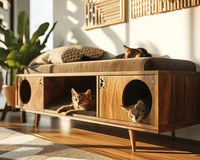Introduction
- Litter box enclosures play a pivotal role in a cat's life by providing a designated, private space for their bathroom needs. These enclosures, available in various designs, offer cats a secluded area for comfort and hygiene while maintaining household cleanliness. They serve as essential tools in training and ensuring a cat's well-being.
- This blog aims to explore cats' preferences regarding litter box enclosures. By delving into their behaviors and tendencies, we seek to uncover whether cats lean towards or shun enclosed litter boxes. Through this investigation, we hope to provide insights into creating a more comfortable restroom environment for our feline companions.

Understanding Cat Behavior and Preferences
Natural Instincts
- Cats are instinctively inclined to bury their waste for hygiene and territorial reasons. Their natural digging behavior is seen as they use litter boxes, replicating outdoor habits. The preference for cleanliness and privacy influences their litter box usage, making it crucial to provide a clean, secluded space for their elimination needs.
- Cats have an instinctual need for privacy and cleanliness, ingrained in their behavior. This stems from their wild ancestry, where concealing waste helped them avoid predators. Their meticulous grooming and preference for secluded spaces extend to their litter box habits, making a private and clean environment crucial for them to feel comfortable and secure. Providing a secluded, clean litter box satisfies these innate needs and encourages proper toileting habits.

Preferences in Litter Box Placement
- Understanding cats' litter box preferences is crucial. Placing litter boxes in quiet, accessible spots away from their food and water encourages regular use. Explore various locations like quiet corners or low-traffic areas, ensuring multiple boxes for multi-cat homes. Respect their privacy and aim for consistency, catering to their natural instincts for a comfortable toileting experience.
- Understanding cats' litter box preferences is crucial. Placing litter boxes in quiet, accessible spots away from their food and water encourages regular use. Explore various locations like quiet corners or low-traffic areas, ensuring multiple boxes for multi-cat homes. Respect their privacy and aim for consistency, catering to their natural instincts for a comfortable toileting experience.

Exploring Litter Box Enclosures
Types of Enclosures
- There are two primary types of litter box enclosures: open and enclosed. Open litter boxes, resembling shallow trays, offer easy access but may emit more odors. Enclosed options feature lids or walls, better containing smells but requiring regular cleaning. Choosing between them depends on balancing convenience and odor control in your home.
- Closed, semi-closed, and furniture-style enclosures offer varied options for cat litter management. Closed enclosures provide odor control, while semi-closed designs balance privacy and ventilation. Furniture-style enclosures merge functionality with aesthetics. DIY options allow customization based on space and preferences.

Benefits of Enclosures
- Enclosures provide a secure haven for cats, catering to their natural instincts for privacy and safety. These spaces offer a sense of territory, reducing stress and anxiety. Enclosures also limit exposure to potential dangers, allowing cats to explore and relax in a controlled environment while feeling comfortable and protected.
- A cat litter box ensures feline privacy while managing odors. Enclosed designs aid in odor control, while dust-free litter options prioritize respiratory health. Routine maintenance minimizes stress for cats. Proper placement and cleanliness foster a comfortable and private space, encouraging consistent litter box use, reducing potential stressors.

Assessing Cat Reactions to Enclosures
Cats' Initial Reaction
- When introduced to a new enclosure, cats might display cautious behavior initially. They could exhibit curiosity, exploring tentatively while also being wary of unfamiliar surroundings. Some might retreat or hide temporarily, needing time to acclimate. Others may express excitement, investigating every nook. Understanding these varied reactions helps in providing a comfortable transition for cats into their new environment.
- Introduce the litter box gradually, allowing the cat to explore at their pace, reducing anxiety. Quiet placement in their designated toileting space fosters positive adoption. This slow approach encourages familiarity and comfort, minimizing stress and increasing the likelihood of consistent and comfortable use.

Signs of Acceptance or Dislike
1.Behavioral Cues Indicating a Cat's Acceptance or Rejection of an Enclosure
Understanding your cat's behavior is key to knowing if they accept or reject an enclosure:
Exploring the Space: A content cat will curiously explore the enclosure, sniffing around, and inspecting corners.
Body Language: Relaxed body posture, ears in a natural position, and slow blinks indicate comfort.
Vocalizations: Contented purring or soft meows signal acceptance.
Avoidance or Hiding: Hissing, flattened ears, or attempts to escape suggest rejection or discomfort.
Litter Box Usage: Regular use of the litter box inside the enclosure signifies acceptance.
Consistency is Key: Over time, consistent positive behavior indicates acceptance, while persistent stress signs denote rejection.
2.Discuss signs of stress, avoidance, or comfort.
Hiding Behavior: Cats seek secluded spots or under furniture.
Excessive Grooming: Over-grooming or focusing on specific areas.
Aggressive Behavior: Growling, hissing, or swatting.
Loss of Appetite: Refusing food or eating significantly less.
Avoiding Eye Contact: Cats avert direct gaze.
Physical Avoidance: Moving away or aloofness.
Refusing Touch: Pulling away or discomfort when touched.
Relaxed Body Language: Relaxed posture and natural ears.
Purring: Audible purring denotes contentment.
Playful Behavior: Engaging in playful activities.
Understanding these cues fosters a supportive environment for your cat, reducing stress and promoting well-being.

Encouraging Cats to Use Enclosures
Creating a Positive Association
- Encouraging cats to accept and use enclosures willingly involves gradual introduction and positive association. Start by leaving the enclosure open, adding familiar scents or treats, and rewarding exploration or use. Patience and consistency help foster comfort and acceptance.
- Positive reinforcement, like treats or praise, encourages litter box use. Placing familiar scents or previous waste aids acceptance. Gradual introduction, leaving the box open initially, helps cats acclimate comfortably to the new space.
Improving Enclosure Appeal
- Enhance enclosure appeal by adding cozy bedding or toys. Provide vertical space with perches or shelves. Offer hiding spots or tunnels for security. Introduce interactive feeders or scratching posts to enrich the environment and stimulate natural behaviors.
- Maintain cleanliness by daily waste removal and regular box cleaning. Choose a size allowing comfortable movement. Place boxes in quiet, accessible spots away from food and busy areas for cat comfort.
Conclusion
- Cats' preferences for litter box enclosures vary. Some prefer enclosed boxes, seeking privacy and reduced exposure to odors. Others favor open designs for a wider view. Enclosures that offer adequate space, cleanliness, and proper placement align with cats' preferences, promoting comfortable and stress-free toileting habits. Understanding individual cat behaviors aids in selecting the most suitable enclosure for their comfort and acceptance.
- Understanding individual cat preferences is crucial. While some cats seek privacy in enclosed spaces, others feel comfortable in open settings. Tailoring the litter box environment to suit each cat's preferences ensures their comfort and encourages consistent use. Observing their behavior helps determine whether they favor privacy or openness, allowing adjustments to create an environment that meets their specific needs and promotes healthy toileting habits.

FAQ
1. Enclosed vs. Open Boxes?
Cat preferences vary - some seek privacy in enclosed boxes, while others prefer open ones for a wider view. Observe your cat's behavior to understand their preference.
2. How to Know if My Cat Likes the Enclosure?
Regular, relaxed use without hesitation indicates acceptance. Avoidance behaviors decrease when cats feel comfortable.
3. Signs of Dislike for the Enclosure?
Signs include avoidance, inconsistent usage, distress vocalization, or stress behaviors post-use.
4. Encouraging Use if Cat Seems Hesitant?
Gradual introduction, scents or treats inside, and positive reinforcement help in acceptance.
5. Choosing the Right Enclosure?
Consider size, space preference, and behavior. Cleanliness and litter type also impact choice.
-------------------------------------------------------------
Your encouragement and support are the driving force of our creation. If you want to support us, you can pay a small amount of Bitcoin or Ethereum to the following address:
Bitcoin:
bc1q56xsdwhnva969w38808yu3erxjrxqludn9ehg9

Ethereum:
0x555C43d02140634250e965F963733Fb32F974D67











